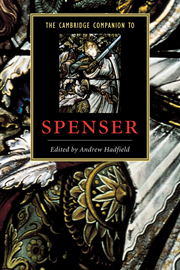Book contents
- Frontmatter
- Introduction
- 1 Spenser's life and career
- 2 Historical contexts: Britain and Europe
- 3 Ireland: policy, poetics and parody
- 4 Spenser's pastorals: The Shepheardes Calender and Colin Clouts Come Home Againe
- 5 The Faerie Queene, Books I-III
- 6 The Faerie Queene, Books IV-VII
- 7 Spenser's shorter poems
- 8 Spenser's languages: writing in the ruins of English
- 9 Sexual politics
- 10 Spenser's religion
- 11 Spenser and classical traditions
- 12 Spenser and contemporary vernacular poetry
- 13 Spenser's influence
- Index
5 - The Faerie Queene, Books I-III
Published online by Cambridge University Press: 28 May 2006
- Frontmatter
- Introduction
- 1 Spenser's life and career
- 2 Historical contexts: Britain and Europe
- 3 Ireland: policy, poetics and parody
- 4 Spenser's pastorals: The Shepheardes Calender and Colin Clouts Come Home Againe
- 5 The Faerie Queene, Books I-III
- 6 The Faerie Queene, Books IV-VII
- 7 Spenser's shorter poems
- 8 Spenser's languages: writing in the ruins of English
- 9 Sexual politics
- 10 Spenser's religion
- 11 Spenser and classical traditions
- 12 Spenser and contemporary vernacular poetry
- 13 Spenser's influence
- Index
Summary
To open Book I of The Faerie Queene is to encounter immediately the question of what kind of poem one is reading. A nationalistic panegyric that eulogises Queen Elizabeth I, whom Spenser calls 'O Goddesse heauenly bright, / Mirrour of grace and Maiestie diuine, / Great lady of the greatest Isle' and, perhaps more honestly, 'O dearest dred' (I, proem, 4), The Faerie Queene has been described as well-written Elizabethan propaganda or at least as a celebration and extension of the queen's political mythology; as political poetry that is complexly engaged, critical of the queen and her politics; as a Protestant poem more shaped by its Reformation context than by fiction or secular literary ideals; as an inspired Humanist summation of mythology that brings into English a wealth of plot material (mythoi) from Irish, Welsh, Scottish, French, Italian, Latin and Greek sources; and as an anatomy of the imagination, a poetic place in which the literary imagination expatiates and dilates to demonstrate how poetry, moral and political value, and literary form intersect. Spenser's great epic-romance is, at some point or another, all of these things. The great challenge for any reader of Spenser, then, is to understand how these different faces of the poem can be brought into one focus.
- Type
- Chapter
- Information
- The Cambridge Companion to Spenser , pp. 106 - 123Publisher: Cambridge University PressPrint publication year: 2001
- 2
- Cited by

